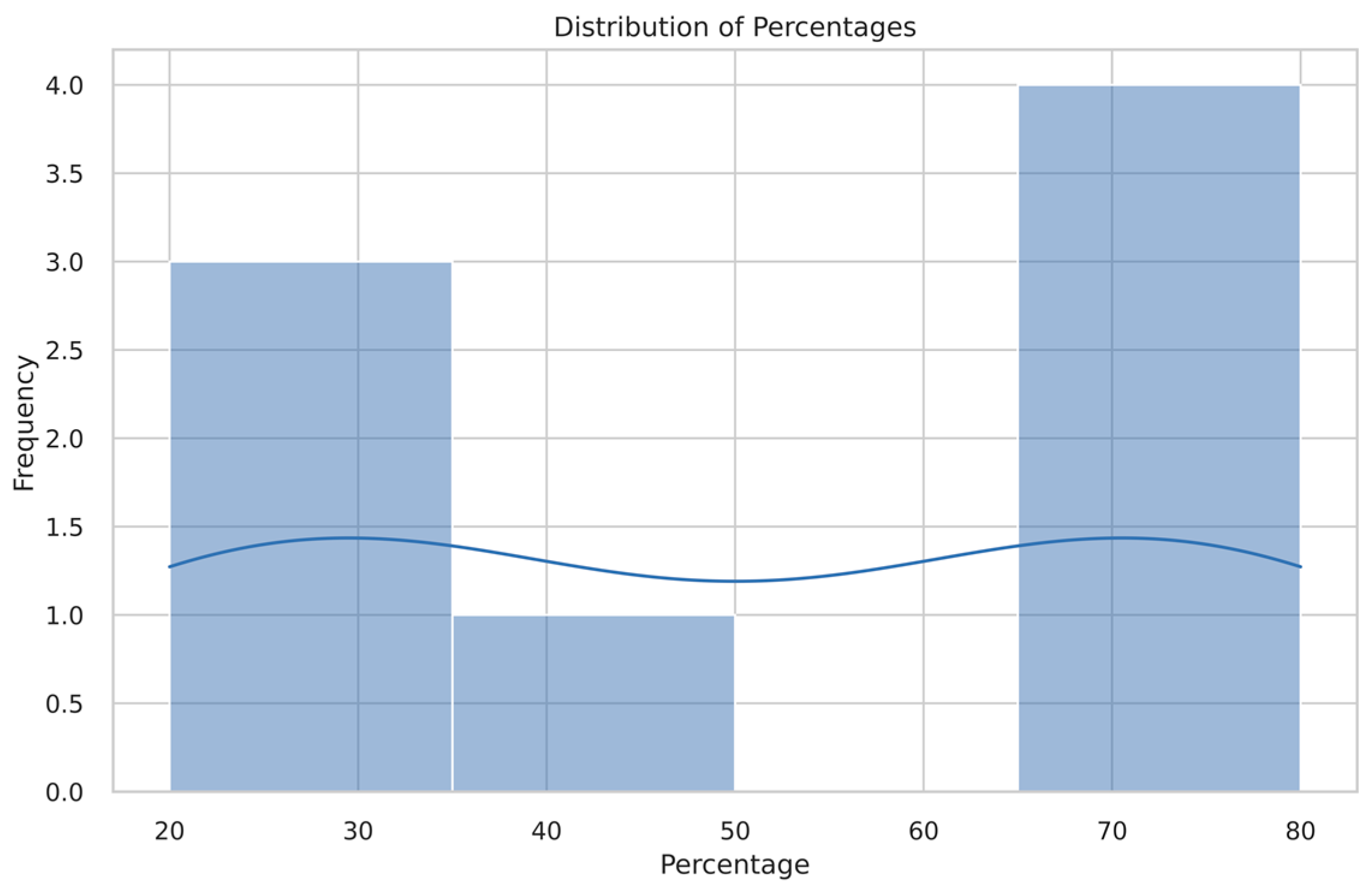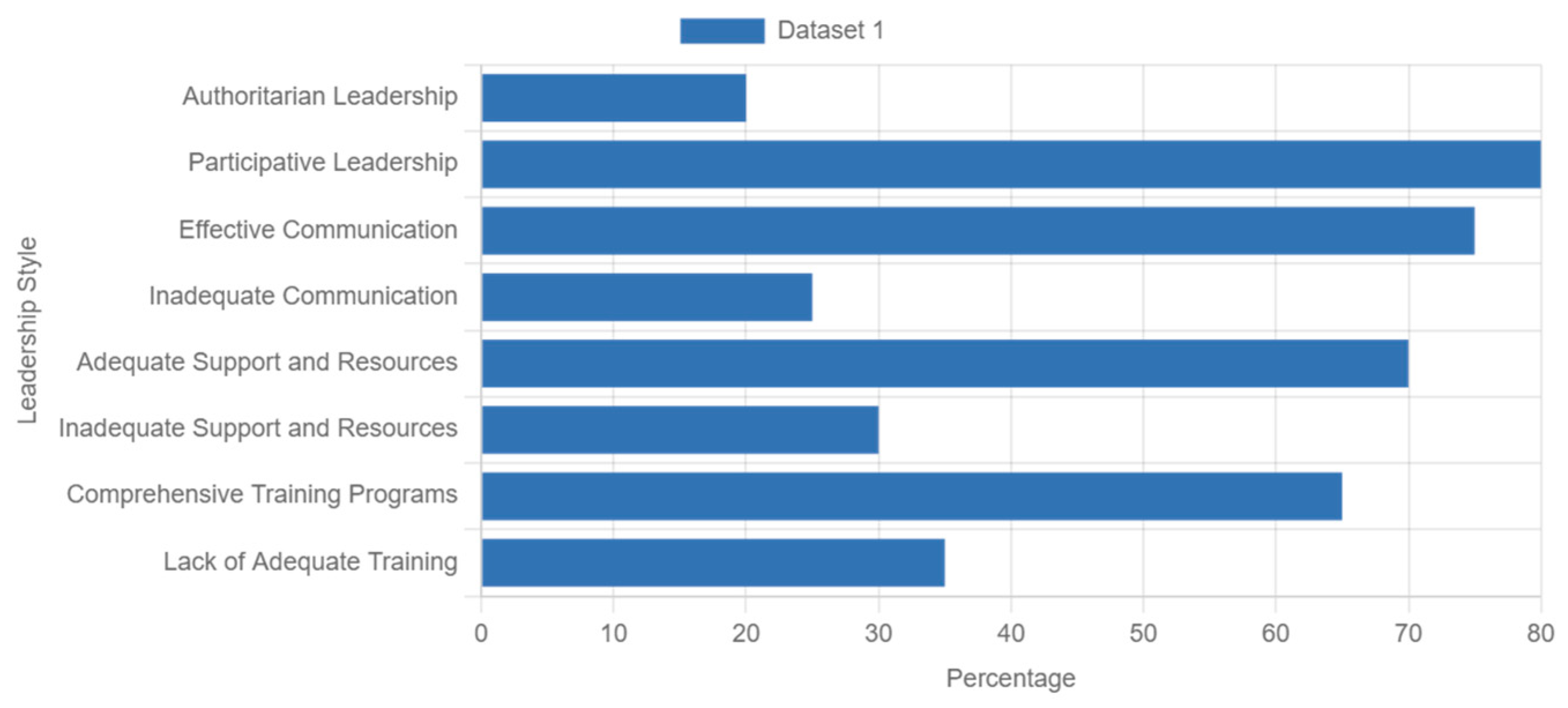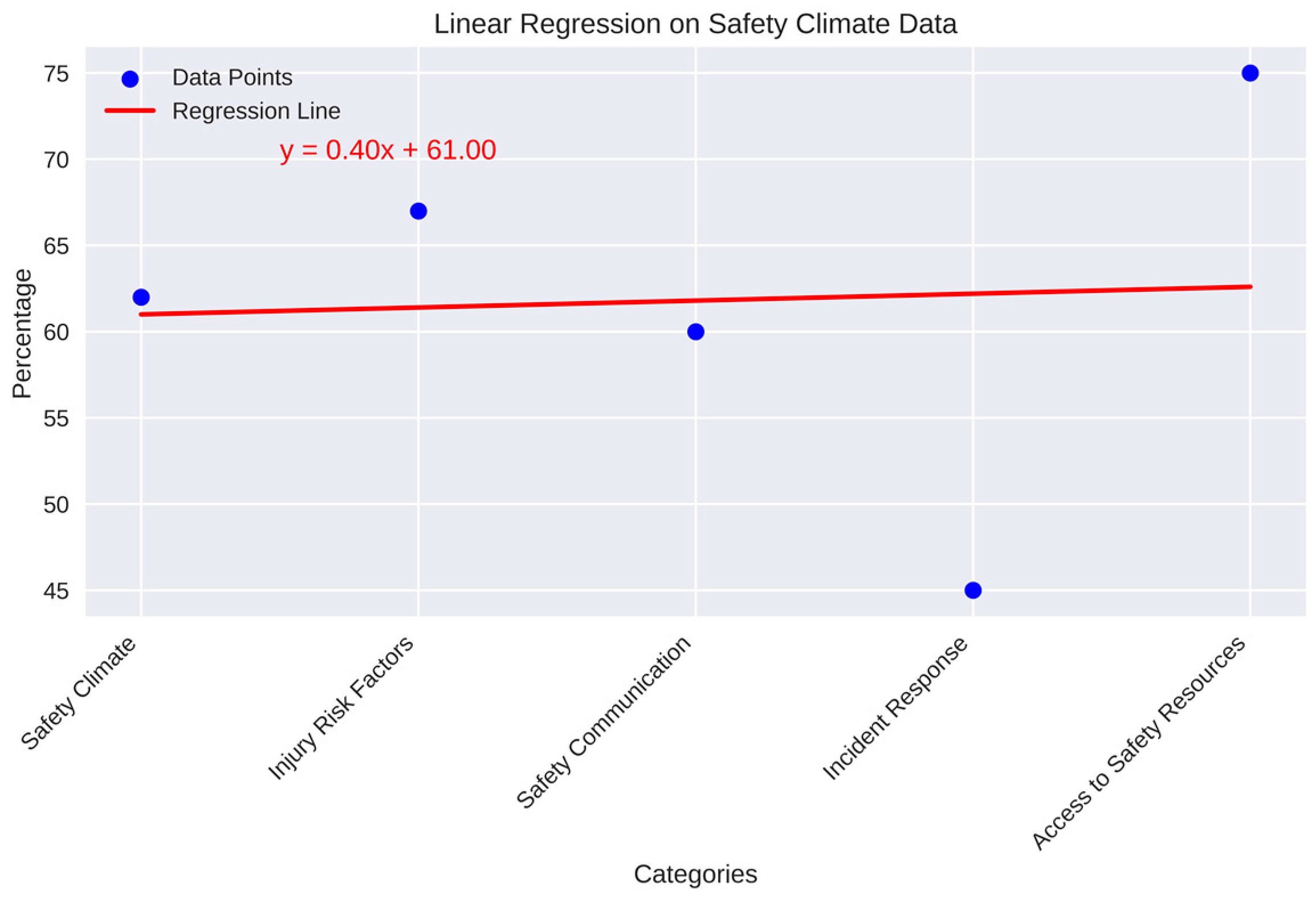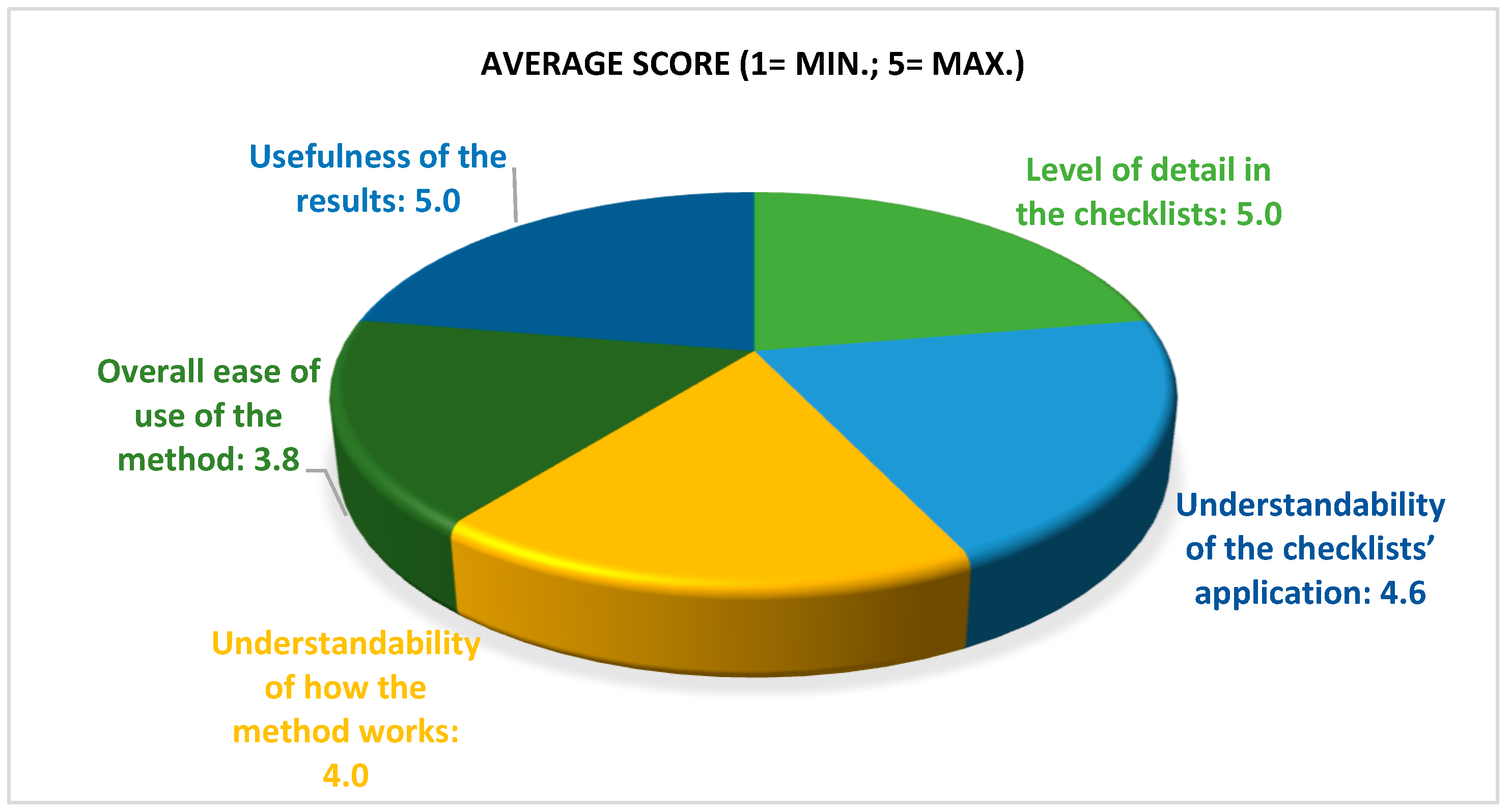Workers’ Exposure to Chemical Risk in Small and Medium-Sized Enterprises: Assessment Methodology and Field Study
Abstract
1. Introduction
2. Materials and Methods
3. Results
4. Discussion
5. Conclusions
Author Contributions
Funding
Institutional Review Board Statement
Informed Consent Statement
Data Availability Statement
Conflicts of Interest
References
- Damalas, C.A.; Eleftherohorinos, I.G. Pesticide exposure, safety issues, and risk assessment indicators. Int. J. Environ. Res. Public Health 2011, 8, 1402–1419. [Google Scholar] [CrossRef] [PubMed] [PubMed Central]
- Lee, K.S.; Lee, H.J.; Lee, J.H. A study on the provide of CMR substances information for Threshold Limit Values (TLVs) chemicals in KMoEL. J. Korean Soc. Occup. Environ. Hyg. 2012, 22, 82–90. [Google Scholar]
- Adeola, F.O. Global Impact of Chemicals and Toxic Substances on Human Health and the Environment. In Handbook of Global Health; Kickbusch, I., Ganten, D., Moeti, M., Eds.; Springer: Cham, Switzerland, 2021. [Google Scholar] [CrossRef]
- Tounsadi, H.; Metarfi, Y.; Taleb, M.; El Rhazi, K.; Rais, Z. Impact of chemical substances used in textile industry on the employee's health: Epidemiological study. Ecotoxicol. Environ. Saf. 2020, 197, 110594. [Google Scholar] [CrossRef]
- Council Directive 89/654/EEC of 30 November 1989 Concerning the Minimum Safety and Health Requirements for the WORKPLACE (First Individual Directive within the Meaning of Article 16 (1) of Directive 89/391/EEC). Available online: https://eur-lex.europa.eu/LexUriServ/LexUriServ.do?uri=CELEX%3A31989L0654%3AEN%3AHTML (accessed on 1 July 2024).
- Commission Directive 2000/39/EC of 8 June 2000 Establishing a First List of Indicative Occupational Exposure Limit Values in Implementation of Council Directive 98/24/EC on the Protection of the Health and Safety of Workers from the Risks Related to Chemical Agents at Work. Available online: https://eur-lex.europa.eu/LexUriServ/LexUriServ.do?uri=CONSLEG:2000L0039:20100108:EN:PDF (accessed on 1 July 2024).
- Directive 2004/37/EC of the European Parliament and of the Council of 29 April 2004 on the Protection of Workers from the Risks Related to Exposure to Carcinogens or Mutagens at Work (Sixth Individual Directive within the Meaning of Article 16(1) of Council Directive 89/391/EEC). Available online: https://eur-lex.europa.eu/legal-content/EN/TXT/PDF/?uri=CELEX:32004L0037 (accessed on 1 July 2024).
- Regulation (EC) No 1907/2006 of the European Parliament and of the Council of 18 December 2006 Concerning the Registration, Evaluation, Authorisation and Restriction of Chemicals (REACH), Establishing a European Chemicals Agency, Amending Directive 1999/45/EC and Repealing Council Regulation (EEC) No 793/93 and Commission Regulation (EC) No 1488/94 as Well as Council Directive 76/769/EEC and Commission Directives 91/155/EEC, 93/67/EEC, 93/105/EC and 2000/21/EC (Text with EEA relevance)Text with EEA Relevance. Available online: https://eur-lex.europa.eu/legal-content/EN/TXT/PDF/?uri=CELEX:02006R1907-20221217 (accessed on 1 July 2024).
- Smidu, E.; Chivu, O.R.; Suciu, O.; Dumitrescu, S. EVA-Risk Method of Risk Assessment of Injury and Professional Illness. Acta Tech. Napoc. Ser. 2023, 66. Available online: https://atna-mam.utcluj.ro/index.php/Acta/article/view/2108/1677 (accessed on 1 July 2024).
- Koçali, K. How To Perform A Risk Assessment Step by Step for Occupational Health and Safety. EURAS J. Eng. Appl. Sci. 2022, 2, 1–19. [Google Scholar] [CrossRef]
- Cioca, M.; Cioca, L.I.; Duță, L. Web Technologies and Multi-Criteria Analysis Used in Enterprise Integration. Stud. Inform. Control 2011, 20, 129–134. [Google Scholar] [CrossRef]
- Moraru, R.I. General Model of the Occupational Health and Safety Management Process and Risk Assessment Tools: A Brief Outline. In Occupational Health and Safety; Rotaru, M., Cioca, L.-I., Eds.; Bentham Science Publishers Pte. Ltd.: Singapore, 2024; pp. 84–106. [Google Scholar]
- Biyikli, Ö.; Aydogan, E. A New Model Suggestion to Estimate the Probability Value in Occupational Health and Safety Risk Assessment. Appl. Math. Inf. Sci. 2016, 10, 663–671. [Google Scholar] [CrossRef]
- Occupational Risk. (n.d.). Safety and Health at Work EU-OSHA. Available online: https://osha.europa.eu/en/tools-and-resources/eu-osha-thesaurus/term/70194i (accessed on 15 June 2024).
- Ansell, J.; Wharton, F. (Eds.) Risk: Analysis, Assessment, Management; Wiley: Chichester, UK; New York, NY, USA, 1992. [Google Scholar]
- Pece, S.; Dăscălescu, A. Risk Assessment Method for Occupational Accidents and Diseases. Available online: https://www.protectiamuncii.ro/pdfs/risk_assessment_method.pdf (accessed on 4 July 2024).
- EESC Study: “Assessment of the Effectiveness of the EU’s SMEs Policies 2007–2015”. Available online: https://www.eesc.europa.eu/sites/default/files/resources/docs/qe-02-17-762-en-n.pdf (accessed on 1 July 2024).
- Batrancea, L.M. Determinants of Economic Growth across the European Union: A Panel Data Analysis on Small and Medium Enterprises. Sustainability 2022, 14, 4797. [Google Scholar] [CrossRef]
- Hasle, P.; Limborg, H.J. Occupational health and safety in small enterprises: The need for a diversity of strategies, Guest editorial. Int. J. Workplace Health Manag. 2011, 4, 104–108. [Google Scholar]
- Choi, M.-K.; Choi, D.-M. A study on the safety management measures efficient chemical substances. J. Korea Saf. Manag. Sci. 2013, 15, 37–50. [Google Scholar]
- Ji, Z.; Pons, D.; Su, Z.; Lyu, Z.; Pearse, J. Integrating Occupational Health and Safety Risk and Production Economics for Sustainable SME Growth. Sustainability 2022, 14, 14565. [Google Scholar] [CrossRef]
- Costantino, F.; Falegnami, A.; Fedele, L.; Bernabei, M.; Stabile, S.; Bentivenga, R. New and Emerging Hazards for Health and Safety within Digitalized Manufacturing Systems. Sustainability 2021, 13, 10948. [Google Scholar] [CrossRef]
- Sørensen, O.H.; Hasle, P.; Bach, E. Working in small enterprises—Is there a special risk? Saf. Sci. 2007, 45, 1044–1059. [Google Scholar] [CrossRef]
- Commission Recommendation of 6 May 2003 Concerning the Definition of Micro, Small and Medium-Sized Enterprises (Text with EEA Relevance) (Notified under Document Number C (2003) 1422). Off. J. L 2003, 124, 36–41. Available online: https://eur-lex.europa.eu/legal-content/EN/TXT/PDF/?uri=CELEX:32003H0361 (accessed on 1 July 2024).
- Kitzinger, J. Qualitative research. Introducing focus groups. BMJ 1995, 311, 299–302. [Google Scholar] [CrossRef]
- National Institute for Occupational Safety and Health [NIOSH]. Qualitative Risk Characterization and Management of Occupational Hazards: Control Banding (CB). NIOSH Publication No. 2009-152. Department of Health and Human Services (NIOSH), 2009. Available online: https://www.cdc.gov/niosh/docs/2009-152/pdfs/2009-152.pdf (accessed on 2 July 2024).
- Makos, K. Hazard identification and exposure assessment related to handling and use of contaminated collection materials and sacred objects. Collect. Forum 2001, 17, 93–112. [Google Scholar]
- Homepage—ECHA. Available online: https://echa.europa.eu/ (accessed on 2 July 2024).
- Centers for Disease Control and Prevention. CDC. Available online: https://www.cdc.gov/ (accessed on 2 July 2024).
- Masi, D.; Cagno, E. Barriers to OHS Interventions in Small and Medium-Sized Enterprises. Saf. Sci. 2015, 71, 226–241. [Google Scholar] [CrossRef]
- Kavouras, S.; Vardopoulos, I.; Mitoula, R.; Zorpas, A.A.; Kaldis, P. Occupational Health and Safety Scope Significance in Achieving Sustainability. Sustainability 2022, 14, 2424. [Google Scholar] [CrossRef]
- ECETOC Human Exposure Assessment Tools Database (heatDB)—ECETOC. ECETOC. Available online: https://www.ecetoc.org/tools/ecetoc-heat-db/ (accessed on 1 June 2022).
- EV, D.G.U. IFA—Hazardous Substances: GESTIS-Stoffenmanager®. Available online: https://www.dguv.de/ifa/gestis/gestis-stoffenmanager/index-2.jsp (accessed on 27 November 2023).
- International Labour Organization. Chemicals and Climate Change in the World of Work: Impacts for Occupational Safety and Health; International Labour Organization: Geneva, Switzerland, 2023; ISBN 9789220392126 (print)/9789220392065 (web PDF). [Google Scholar]
- Ho, C.-C.; Chen, M.-S. Risk assessment and quality improvement of liquid waste management in Taiwan University chemical laboratories. Waste Manag. 2018, 71, 578–588. [Google Scholar] [CrossRef]
- Harms-Ringdahl, L. Safety Analysis: Principles and Practice in Occupational Safety, 2nd ed.; Taylor & Francis: London, UK, 2001. [Google Scholar]
- Dehdashti, A.; Fatemi, F.; Jannati, M.; Asadi, F.; Kangarloo, M.B. Applying health, safety, and environmental risk assessment at academic settings. BMC Public Health 2020, 20, 1328. [Google Scholar] [CrossRef]
- Jensen, P.L.; Alstrup, L.; Thoft, E. Workplace assessment: A tool for occupational health and safety management in small firms? Appl. Ergon. 2001, 32, 433–440. [Google Scholar] [CrossRef] [PubMed]
- Walker, D.; Tait, R. Health and safety management in small enterprises: An effective low cost approach. Saf. Sci. 2004, 42, 69–83. [Google Scholar] [CrossRef]
- Abd Ali, A.; Shaalan, N.; Al-Dahhan, W.; Hairunisa, N.; Yousif, E.A. Technical evaluation of a chemistry laboratory: A step forward for maintaining safety measures. Orient. J. Phy. Sci. 2017, 2, 68–71. [Google Scholar] [CrossRef]
- Kogi, K. Low-cost risk reduction strategy for small workplaces: How can we spread good practices? La Medicina Del Lavoro 2006, 97, 303–311. [Google Scholar] [PubMed]
- Adhikari, P. Errors and accidents in the workplaces. Sigurnost 2015, 57, 127–137. [Google Scholar]
- Bęś, P.; Strzałkowski, P. Analysis of the Effectiveness of Safety Training Methods. Sustainability 2024, 16, 2732. [Google Scholar] [CrossRef]




| Sector | No. of SMEs | Main Characteristics | Data Collection Methods |
|---|---|---|---|
| Agriculture | 3 | No. of employees: 6–25 Profile: 1 cereal planting, 1 fruit growing, and 1 vegetable growing OSH: 2 had external services and 1 had a designated worker All three were rural | On-site observations, textual content analysis of OSH documents, focus group discussions, and chemical risk identification |
| Research activities in laboratories | 3 | No. of employees: 25–80 OSH: 2 had internal services and 1 had external services All three were urban | |
| Conservation and restoration laboratories | 3 | No. of employees: 6–25 OSH: 2 had internal services and 1 had external services All three were urban |
| Activity of Participating SMEs | Focus Group No. | Focus Group Code | No. of Participants/Group |
|---|---|---|---|
| Agricultural | 3 | A1, A2, A3 | 4 |
| Research activities in laboratories | 3 | R1, R2, R3 | 3 |
| Conservation and restoration laboratories | 3 | C1, C2, C3 | 3 |
| Components of the Work System | Chemical Risk Factors |
|---|---|
| Production process | Exposure to toxic, caustic, or carcinogenic substances through injection, ingestion, or contact with the skin or eyes can result in harmful effects. |
| Working environment | Inhaling may result in harmful effects when exposed to gasses, vapors, or airborne particles of toxic, carcinogenic or caustic aerosols. Airborne flammable substances increase the risk of chemical fires. An explosive atmosphere may be formed when mixing flammable substances with ambient air. |
| Task | Potential risks arising from operations, regulations, incorrect protocols, absence of established procedures, incorrect order of procedures, inadequate personal protective equipment, and improper marking of containers. |
| Workers | Mistakes resulting from mishandling, unsynchronized operations, delays, halts in hazardous locations, neglecting tasks, and failure to use personal protective equipment. Chemical fires can occur due to mishandling and failure to follow safe work practices. |
| Components of the Work System | Chemical Risk Factors |
|---|---|
| Production means | Exposure to hazardous substances used as raw or auxiliary materials through ingestion or contact with the skin or eyes; possibility of substances being involved in hazardous reactions; possibility of accidents caused by pressurized gasses or hot liquids. |
| Working environment | Gasses and liquid or solid aerosols as well as airborne particles can cause health problems (by inhalation) or by generating fire and explosion accidents. |
| Task | Risks arising from, e.g., incorrect or incomplete OSH protocols, absence of established working procedures. |
| Workers | Risks resulting from mishandling, unsynchronized operations, delays, halts in hazardous locations, neglecting tasks, or not using personal protective equipment (PPE). |
| Severity Class (S) | Severity of the Consequences | |
|---|---|---|
| Consequences | ||
| 1 | Small | Minor incidents resulting in temporary inability to work for up to three days (self-healing). |
| 2 | Medium | Temporary disability of 3–45 days, treatable with medical care and reversible outcomes. |
| 3 | Large | Medical care and hospitalization may be necessary for individuals facing a reversible inability to work for a period for 45–90 days. The individual’s work capacity is reduced by at least 50%, resulting in permanent consequences that prevent them from performing professional activities (classified as third-degree disability). |
| 4 | Severe | Permanent consequences resulting in complete loss of ability to work, but with potential for self-care, self-direction, and spatial awareness (classified as a second-degree disability). The irreversible effects of first-degree disability include total loss of ability to work, self-care, self-management, or spatial orientation. |
| 5 | Very severe | Death. |
| No. crt. | Description | Controlled (C) | Commonly Controlled (CC) | Occasionally Controlled (OC) | Difficult to Control (DC) | Uncontrolled (UC) | Not Applicable (N/A) |
|---|---|---|---|---|---|---|---|
| 100% | 75% < OC < 100% | 25% < UC < 75% | 0% < DC < 25% | 0% | |||
| 1 | |||||||
| TOTAL | |||||||
| C | CC | OC | DC | UC |
| No. | Compliance Indicator | Definition | |
|---|---|---|---|
| Legal Compliance Other Than OELS | Compliance of Measured/Estimated Exposure Compared to OELs | ||
| 1. | C—compliant | C = 100% | C < 30% of OEL |
| 2. | CC—commonly compliant | 75% ≤ CC < 100 | 30% OEL ≤ CC < 50% OEL |
| 3. | OC—occasionally compliant | 25% ≤ OC < 75 | 50% OEL ≤ OC < 75% OEL |
| 4. | DC—deficient compliance | 0% ≤ DC < 25% | 75% OEL ≤ DC < 100% OEL |
| 5. | UC—uncompliant | UC = 0%. | UC > 50% OEL |
| CF | F |
|---|---|
| FC < 0.15 | 1 |
| 0.15 < FC < 0.50 | 2 |
| FC > 0.50 | 3 |
| Texp (%) | 0–20% | 20–40% | 40–60% | 60–80% | 80–100% |
|---|---|---|---|---|---|
| Time Class (T) | 1 | 2 | 3 | 4 | 5 |
| Occurrence | Probability Class | Couples (Frequency Class, Exposure Time Class) (F,T) |
|---|---|---|
| Very rare | 1 | (1,1); (1,2); (2,1) |
| Rare | 2 | (1,3); (1,4); (2,2); (3,1) |
| Uncommon | 3 | (1,5); (2,3); (3,2) |
| Common | 4 | (2,4); (2,5); (3,3) |
| Very common | 5 | (3,4); (3,5) |
| Probability Classes | |||||||
|---|---|---|---|---|---|---|---|
| 1 | 2 | 3 | 4 | 5 | |||
| Very Rare | Rare | Uncommon | Common | Very Common | |||
| Severity Classes | Consequences | (1,1) (1,2) (2,1) | (1,3) (1,4) (2,2) (3,1) | (1,5) (2,3) (3,2) | (2,4) (2,5) (3,3) | (3,4) (3,5) | |
| 5 | Very severe | Death | (5,1) | (5,2) | (5,3) | (5,4) | (5,5) |
| 4 | Severe | Disablement | (4,1) | (4,2) | (4,3) | (4,4) | (4,5) |
| 3 | Large | Medical care and hospitalization for a period of 45–90 days | (3,1) | (3,2) | (3,3) | (3,4) | (3,5) |
| 2 | Medium | Medical care and hospitalization for a period of 3–45 days | (2,1) | (2,2) | (2,3) | (2,4) | (2,5) |
| 1 | Small | Medical care and hospitalization for <3 days | (1,1) | (1,2) | (1,3) | (1,4) | (1,5) |
| Measured Values (MVs) | MV < 30% | 30% ≤ MV < 70% | 70% ≤ MV < 100% | MV ≥ 100% |
|---|---|---|---|---|
| MV classes | 1 | 2 | 3 | 4 |
| Risk Level | Couple (Frequency, Measured Value Class Chemical Risk) (F,MV) | Security Level | ||
|---|---|---|---|---|
| 1 | Small | (1,1) (1,2) | 5 | Maximum |
| 2 | Medium | (1,3) (2,1) (2,2) | 4 | Very large |
| 3 | Large | (3,1) (3,2) | 3 | Large |
| 4 | Very large | (1,4) (2,3) | 2 | Medium |
| 5 | Maximum | (2,4) (3,3) (3,4) | 1 | Small |
| Workplace: | Evaluation Sheet No. | Working Time: 8 h | ||||||
|---|---|---|---|---|---|---|---|---|
| Nrg = 3 | Nrgr = 2.09 | |||||||
| Risk Factor | S | P | NPRL | Recommended Measures | S | P | NPRRL | |
| Means of Production | ||||||||
| Working with toxic substances | 2 | 2 | 2 | Workers are not allowed to use toxic substances if they have skin injuries or mucous membrane issues | 2 | 1 | 1 | |
| Working with flammable substances | 3 | 2 | 2 | Toxic or flammable substances that spill on the floor will be neutralized using materials specified by the manufacturer for each substance and will be disposed of at the designated garbage collection site | 3 | 1 | 1 | |
| Working Environment | ||||||||
| Vapours, aerosols, dusts—carcinogens: gasses, toxic vapours from varnishes and paints | 4 | 2 | 3 | Ensuring an effective ventilation; Conducting measurements of chemical gases in the workplace | 4 | 1 | 2 | |
| Particulate matter in air, gasses or vapours—explosives: gases, flammable vapors from used substances | 5 | 2 | 3 | Ensuring an efficient ventilation system to eliminate harmful gasses; Proper airing, ventilation, and mandatory gas checks; Providing workers with appropriate PPE | 5 | 1 | 2 | |
| Task | ||||||||
| Insufficient training | 5 | 2 | 3 | Periodic training of workers on the European systems for classifying and labeling chemical substances | 5 | 1 | 2 | |
| Worker | ||||||||
| Wrong actions (incorrect handling of containers containing substances) | 5 | 3 | 4 | Storing chemicals in labeled and chemical-resistant containers; Using handling equipment like pumps and valves to minimize direct contact with substances; Providing training on the proper handling of the substances used | 5 | 2 | 3 | |
| Typology | Measures | Actions |
|---|---|---|
| Primary measures | Risk elimination | The measures must directly impact the source of risk factors (intrinsic prevention). |
| Secondary measures | Risk isolation | While risk factors may persist, taking collective protection measures can prevent or reduce their impact on workers. |
| Tertiary measures | Risk avoidance | Organizational measures and regulations on behavior act as barriers to the interaction between risk factors and workers. |
| Quaternary measures | Isolation of the worker | Individual protection can be achieved by wearing personal protective equipment to limit the impact of risk factors. |
Disclaimer/Publisher’s Note: The statements, opinions and data contained in all publications are solely those of the individual author(s) and contributor(s) and not of MDPI and/or the editor(s). MDPI and/or the editor(s) disclaim responsibility for any injury to people or property resulting from any ideas, methods, instructions or products referred to in the content. |
© 2024 by the authors. Licensee MDPI, Basel, Switzerland. This article is an open access article distributed under the terms and conditions of the Creative Commons Attribution (CC BY) license (https://creativecommons.org/licenses/by/4.0/).
Share and Cite
Badea, D.O.; Darabont, D.C.; Ivan, I.; Ciocîrlea, V.; Stepa, R.A.; Chivu, O.R. Workers’ Exposure to Chemical Risk in Small and Medium-Sized Enterprises: Assessment Methodology and Field Study. Sustainability 2024, 16, 6308. https://doi.org/10.3390/su16156308
Badea DO, Darabont DC, Ivan I, Ciocîrlea V, Stepa RA, Chivu OR. Workers’ Exposure to Chemical Risk in Small and Medium-Sized Enterprises: Assessment Methodology and Field Study. Sustainability. 2024; 16(15):6308. https://doi.org/10.3390/su16156308
Chicago/Turabian StyleBadea, Daniel Onuț, Doru Costin Darabont, Iulian Ivan, Vicențiu Ciocîrlea, Raluca Aurora Stepa, and Oana Roxana Chivu. 2024. "Workers’ Exposure to Chemical Risk in Small and Medium-Sized Enterprises: Assessment Methodology and Field Study" Sustainability 16, no. 15: 6308. https://doi.org/10.3390/su16156308
APA StyleBadea, D. O., Darabont, D. C., Ivan, I., Ciocîrlea, V., Stepa, R. A., & Chivu, O. R. (2024). Workers’ Exposure to Chemical Risk in Small and Medium-Sized Enterprises: Assessment Methodology and Field Study. Sustainability, 16(15), 6308. https://doi.org/10.3390/su16156308







